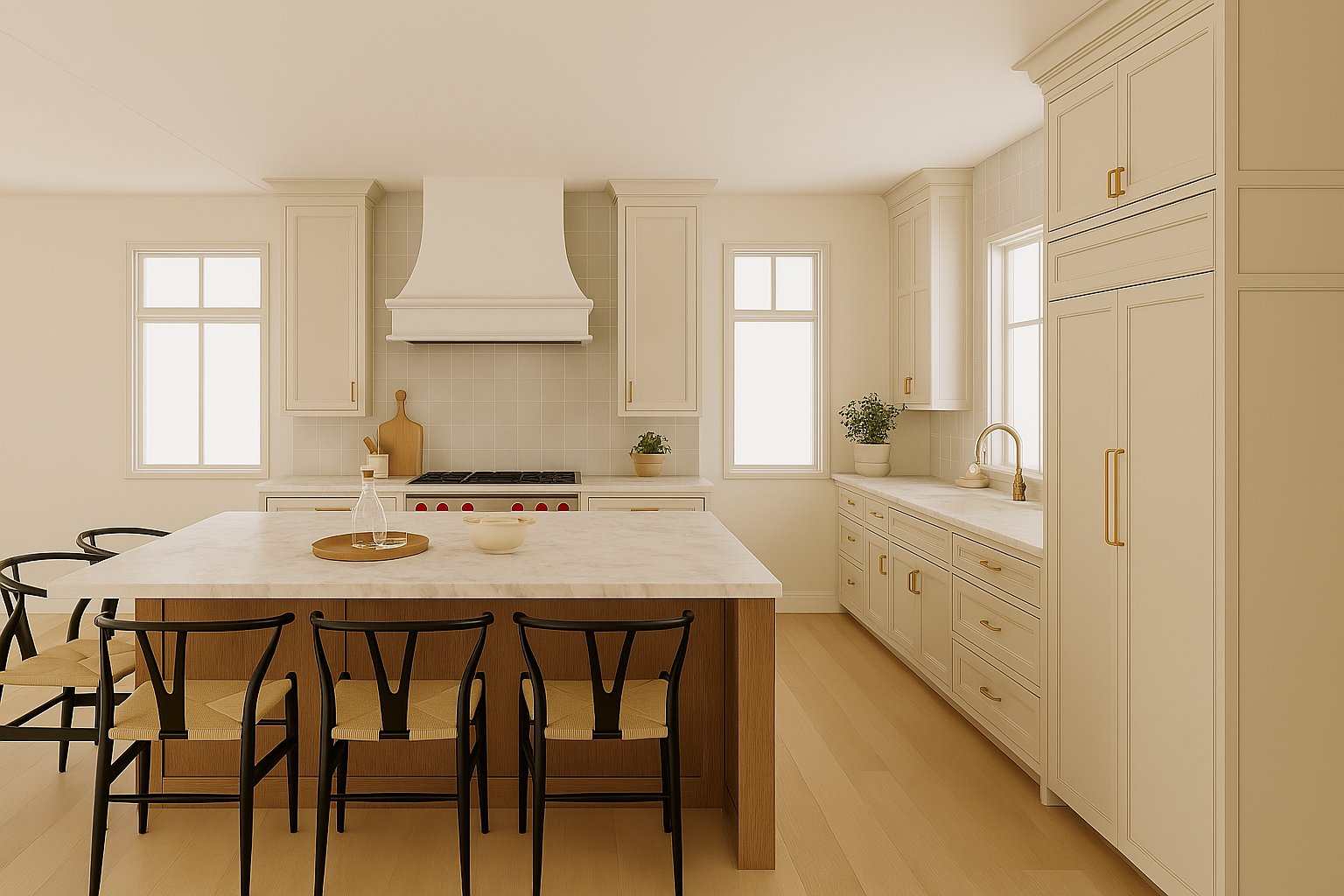Kitchen Cabinet Finish Tips from a Designer: Why I Use Factory-Finished in Every Project
A designer’s honest take on the upgrade that makes cabinets look good for years
If you're in the middle of a renovation and starting to realize your “painted cabinet” line item comes with a lot of fine print, you're in the right place.
Because, believe it or not, not all painted cabinets are created equal. And the kind of kitchen cabinet finish you choose will absolutely affect how your kitchen looks five years from now… and how frustrated you’ll feel six months after move-in when your base cabinets are already chipped to oblivion.
Let’s get into it with no fluff and a few painfully real examples (including what I used in my own kitchen).
What Is the Best Kitchen Cabinet Finish? (Spoiler: It’s Not a Paintbrush and Good Intentions)
When clients ask me about the best kitchen cabinet finish, I always ask them one thing first:
“Are you talking about how it looks on install day, or how it holds up after 200 spaghetti nights and one toddler with a dump truck?”
Because, sure, that brushed-on look can seem fine at first. But six months down the line? You’re emailing me a photo of a base cabinet that’s missing paint in the exact shape of your dog’s favorite food bowl.
That’s why I use factory-finished cabinets in every single project. Every. Single. One. Here’s why.
Site-Sprayed vs. Factory-Finished Cabinets: What You Actually Need to Know
There are two ways to get painted cabinets:
Site-sprayed cabinets, which are painted after installation, are often right in your home
Factory-finished cabinets, which are painted in a controlled environment before they ever reach your doorstep
Let’s talk about site-sprayed first. In theory, it sounds fine. Someone shows up, tapes off the room, sets up their sprayer, and paints your cabinets right there. But in reality?
You’re battling dust and debris (no matter how well things are sealed)
You’re at the mercy of humidity, temperature shifts, and drying time
You’re getting a one-part paint product (usually something like a Sherwin-Williams cabinet-grade formula), which hardens as it dries but doesn’t cure with the same strength
Even the highest-end site spray jobs still scuff and chip more easily than factory finishes. And while that might not sound like a huge deal now, it will feel like a big deal when the junk drawer handle pulls off a flake of paint with it.
Why Factory-Finished Cabinets Are Worth It (Even When You’re Watching Your Budget)
Here’s what you’re getting with a factory-finished cabinet:
A two-part catalyzed polyurethane finish, which is created by mixing the paint with a hardener that bonds like epoxy
A dust-free, temperature-controlled environment
Paint that’s baked on, not just air-dried
A super-smooth, ultra-durable surface that resists scuffs, nicks, and flaking
It’s basically like comparing a manicure done in your living room to a professional gel set at the salon. Same idea, very different result.
And before you panic about cost, this is actually one of the smartest ways to protect your investment during a kitchen renovation on a budget. A cabinet finish that lasts means fewer repairs, less repainting, and more “hey, this still looks great” moments long after the contractors leave.
Real Talk: This Is What I Used in My Own Kitchen
I practice what I preach here. In my own kitchen, I chose factory-finished cabinets with a catalyzed polyurethane finish. Not because I had some unlimited design budget, but because I’ve seen what happens when you cut corners on cabinet durability.
I chose this because I wanted a kitchen that could handle real life. Messy meals, busy mornings, and everything in between should still look good years down the line. If you have a family, cook meals more days than not, and are tired of watching your hard finishes fall apart, this kind of durability makes a real difference.
Still Not Sure What Finish to Choose? Here’s What Else to Consider
A few questions I ask clients when they’re torn:
Do you have young kids, pets, or roommates who treat cabinet doors like jungle gyms?
Is this your “forever kitchen” or a short-term update?
Are you willing to touch up paint regularly, or do you want to set it and move on?
Are you aiming for a flawless finish or okay with a little character as the kitchen ages?
👉If you need a little more help navigating choices like this, you might also find this helpful: Check out this guide to remodeling your home on a budget. It’s full of smart ways to protect your vision and your wallet at the same time.
Bonus: Other Finish Details to Think Through
While you’re deep in cabinetry decisions, don’t forget:
Wood type matters. Curious about how that plays into the finish? I break it down in this post.
Tile install is the next big trap for renovation regrets. If you’re lining things up now, read this post first.
And yes, gray is still alive, but it needs to be used with intention, and here’s what I mean.
The Bottom Line on Your Kitchen Cabinet Finish
Choosing the right kitchen cabinet finish is one of those decisions that doesn’t always feel urgent… until you start seeing little chips and scratches that make everything feel unfinished.
When you invest in factory-finished cabinets, you’re choosing durability that holds up to daily life, not just showroom lighting. It’s the difference between needing to baby your kitchen and being able to actually live in it.
Want to avoid common mistakes before they cost you money or your sanity?
⭐ Grab my FREE guide: Kitchen Renovation on a Budget→Top 7 Mistakes to Avoid When Choosing Kitchen Cabinets
This will walk you through exactly what to watch for, so you can spend your budget wisely and finish with a kitchen that feels like home.

